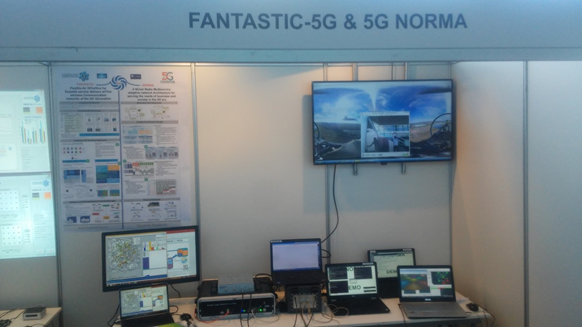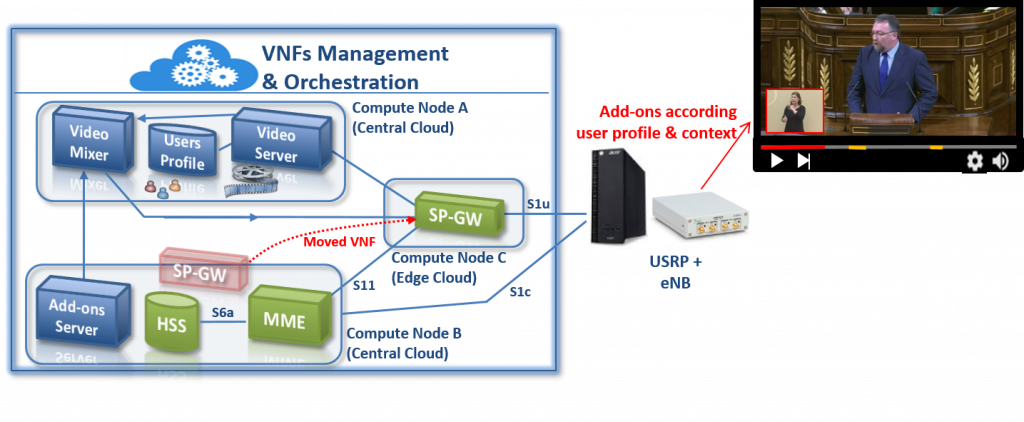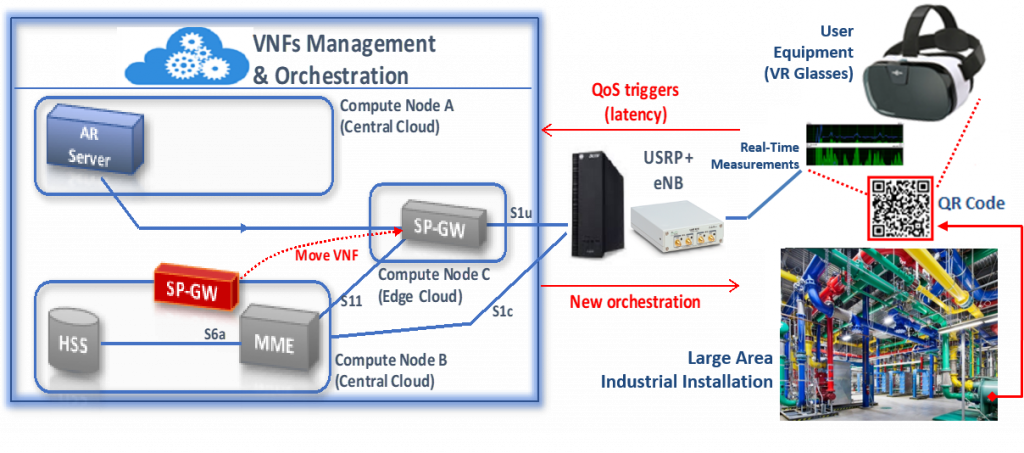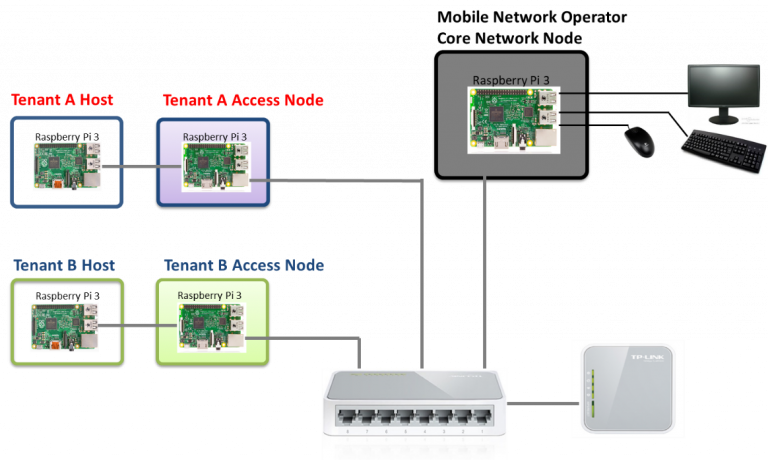In order to demonstrate the breakthrough innovations we are proposing in the framework of the 5G NORMA project, we carefully defined a set of demonstrators that showcase very heterogeneous Key Performance Indicators (KPIs) that can benefit from the introduction of the 5G NORMA concepts.
More specifically, we develop the following four demonstrators: Native Multi-service Architecture (Demo #1), Service-aware QoE/QoS Control and Orchestration (Demo #2), the Secured Multi-Tenancy Virtual Network Resources Provisioning via V-AAA (Demo #3) and the Online Interactive 5G NORMA Business Cases Evaluation Tool (Demo #4).
If you wish to know more about these demonstrations, please check Deliverable 6.2.
5G NORMA supports service flexibility using the decomposition of mobile network functions and allocation of them to the edge cloud or central cloud. It is done adaptively based on the service requirements and the transport network capabilities. This demo aims to present the proof-of-concept for a flexible, adaptive, intelligent, and service-aware (de)composition of NFs and services. The key elements of this demo are shown in the figure below and described in the following:
· An SDM-C and software based eNB. These two components form the software part of this demo. They have been developed by NOMOR.
· A hardware eNB including the implementation of the SDM-C communication protocol, which composes the hardware part of the demo. This is provided by AZCOM.

The SDM-C is in charge of the (de)composition of NFs to optimise the network for high data rate services (e.g., HD video streaming) as well as reduced latency services (e.g., video live streaming).
This demo was shown in several relevant international events (MWC-2016/17, EuCNC’16, ICC’16, among others). The following figure shows the most recent deployment at the EuCNC 2017:

Native Multi-Service Architecture demo at the Fantastic-5G and 5G NORMA booth at EuCNC 2017
This second demonstrator focuses on the Network Slicing key concept, but specifically considers QoS/QoE-aware control and NFs virtualization and orchestration aspects. The general idea of this demo is to deploy two different network slices on the cloud infrastructure: one with a reduced latency service and another one with a mobile broadband service. This demonstrator was integrated by University “Carlos III” of Madrid (UC3M) and Atos.
The demonstration has several goals. The main one is to show how an ETSI NFV Management & Orchestration platform could be used to deploy, manage and orchestrate the network services previously named on different network slices. In this respect, the main objectives are the dynamic re-orchestration of a particular NS forwarding graph, and also, the placement of certain VNFs in the appropriate host (simulating the 5G edge/central nodes). In both cases, QoS/QoE influence factors are used to trigger the re-orchestration function.
Two network slices (shown below) were defined :
1. an eMBB slice, focused on adding contextual captions to streaming media according to the user profile and surrounding context.
2. a Reduced Latency slice, focused on reading real-time physical measurements triggered by QR labels

Service-aware QoE/QoS control – eMBB Slice

Service-aware QoE/QoS control –Reduced Latency Slice
The Secured Multi-Tenancy Virtual Network Resources Provisioning via Virtualized Authentication Authorization Accounting demonstration is a complementary demonstration in 5G NORMA aiming to illustrate 5G NORMA tenant data isolation, secured virtual network resources provisioning, and hierarchical and distributed virtualised AAA (V-AAA) solutions proposed in 5G NORMA’s Work Package 3. It’s also aligned with the flexible 5G network architecture and V-AAA principles developed in that work package. This demonstrator was developed by the King’s College of London (KCL).
Demo 3 has been designed to execute a series of well-defined steps, as a form of storyline, summarized in the figure below.

This demo provides a simple infrastructure for conducting small-scale repeatable experiments of the 5G NORMA architecture, especially those involving secure multi-tenancy and multi-tenant data isolation on the access network (edge cloud). The testbed is based on 1) commodity hardware, i.e., Raspberry Pi, home Wi-Fi router and switch and 2) open source software, i.e., Ryu controller, Open Authentication protocol, CouchDB and OVS, which has been configured and extended to provide a hierarchical and distributed database cluster for tenant isolation and replication of the Tenant data (e.g. billing data, Tenant service logs). The hardware and network topology can be seen in the figure below.

Finally, the fourth demonstrator focus on the evaluation of business aspects of 5G NORMA through a web-based platform. This demonstrator was developed by Real Wireless (RW).
This online demo presents the economic benefits of a 5G network, which is one of the key principles in the 5G NORMA project. The online interactive tool demonstrates the key outputs and sensitivities of the evaluation cases selected as part of the overall project evaluation framework. The tool shows the economic feasibility of the 5G NORMA architecture by looking at three different evaluation cases:
· Evaluation case C.1: Baseline evaluation case – comparison of 5G NORMA with evolved legacy (LTE-A Pro) networks for MBB services;
· Evaluation case C.2: Multi-tenant evaluation case – comparison of single and multi-operator networks for MBB services;
· Evaluation case C.3: Multi-service evaluation case – comparison of single and multi-service networks.
The demo is developed by using an online web-based interactive dashboard approach. The user can simply use a web browser to check the results. The user can check costs or revenues for the defined evaluation cases. The values provided via the web-based interface are abstracted from the network modelling results developed in 5G NORMA’s Work Package 2 as described in more details in D6.1. The economic validation tool is dependent on the analysis and results of the socio-economic model developed in Work Package 2.
The main page of the demonstrator can be seen below. This demo can be access online in the following link : www.realwireless.eu/main.html
